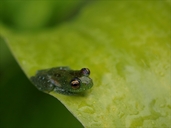|
Description
A medium-sized green treefrog, males about 30 mm SVL,
females unknown. Back green, with many dispersed, small whitish spots. Black
pigmentations on back, head, and around the nostrils. Venter whitish, yellow
in the middle, bluish on the throat. White lateral fringes on lower arm and
tarsus. Iris yellowish with symmetrical reddish markings. Skin on the back smooth.
Nostrils equidistant between eye and tip of snout. Tympanum indistinct. Tibiotarsal
articulation reaches the nostril.
Webbing of the hand: a trace of webbing between 1 and 2i, 2e(1) 3i(2.5), 3e(1),
4(1). Webbing of the foot: 1(0.5), 2i/e(0.5), 3i(0.5-1), 3e(0.5), 4i/e(1), 5(0).
Males with nuptial pads and a single, subgular vocal sac.
Similar species: Boophis albipunctatus is extremely similar in morphology and life
colouration. It has fewer or no dark spots on the back, but mainly differs by
call. Other species of the B. luteus- and B. rappiodes-group have many fewer or no
white dots on the back.
Distribution and Habitat
Country distribution from AmphibiaWeb's database: Madagascar
An’Ala, Andasibe, Anjanaharibe, Masoala. It occurs around 900m asl in pristine rainforest (Glaw and Andreone 2008).
Life History, Abundance, Activity, and Special Behaviors
Males call at night from trees more than 3 m high along brooks in forest.
They are often associated with Boophis luteus, from which the call of B. sibilans
can be hard to distinguish in choruses.
Call (from the terra typica, 22°C): Composed of a series of melodious frequency-modulated
whistling notes. Note duration is 111-167 ms (mean 147 ms), repeated after intervals
of 721-1443 ms (mean 975 ms), the note repetition rate is 1-1.6/s and frequency
ranges between 2.8 and 3.8 kHz. Sometimes such series are followed by note-groups
(about 4-7 notes) with a higher repetition rate (4.4/s).
Eggs and tadpoles: Unknown.
Breeding takes place in streams (Glaw and Andreone 2008).
Trends and Threats
Data Deficient: uncertainties as to its extent of occurrence, status and ecological requirements. This species occurs in the Réserve Spéciale d’Analamazaotra (Glaw and Andreone 2008). Possible reasons for amphibian decline General habitat alteration and loss
Habitat modification from deforestation, or logging related activities
Intensified agriculture or grazing
Urbanization
Habitat fragmentation
Comments
Taken with permission from Glaw and Vences (2007).
References
Glaw, F. and Andreone, F. (2008). Boophis sibilans. In: IUCN 2008. 2008 IUCN Red List of Threatened Species. www.iucnredlist.org. Downloaded on 14 April 2009.
Glaw, F. and Vences, M. (1994). Amphibians and Reptiles of Madagascar. M. Vences and F. Glaw Verlags GbR., Köln.
Glaw, F., and Vences, M. (2007). Field Guide to the Amphibians and Reptiles of Madagascar. Third Edition. Vences and Glaw Verlag, Köln.
Originally submitted by: Miguel Vences and Frank Glaw (first posted 2000-10-30)
Edited by: Henry Zhu (2009-05-05)Species Account Citation: AmphibiaWeb 2009 Boophis sibilans <https://amphibiaweb.org/species/4361> University of California, Berkeley, CA, USA. Accessed May 24, 2025.
Feedback or comments about this page.
Citation: AmphibiaWeb. 2025. <https://amphibiaweb.org> University of California, Berkeley, CA, USA. Accessed 24 May 2025.
AmphibiaWeb's policy on data use.
| 